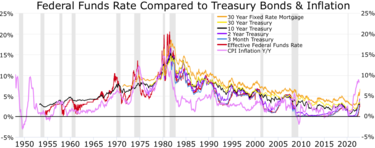
Quantitative tightening (QT) is a contractionary monetary policy tool applied by central banks to decrease the amount of liquidity or money supply in the economy. A central bank implements quantitative tightening by reducing the financial assets it holds on its balance sheet by selling them into the financial markets, which decreases asset prices and raises interest rates.[1] QT is the reverse of quantitative easing (or QE), where the central bank prints money and uses it to buy assets in order to raise asset prices and stimulate the economy. QT is rarely used by central banks, and has only been employed after prolonged periods of Greenspan put-type stimulus, where the creation of too much central banking liquidity has led to a risk of uncontrolled inflation (e.g. 2008, 2018 and 2022).[2][3]
- ^ Engemann, Kristie (July 17, 2019). "What Is Quantitative Tightening?". Federal Reserve Bank of St. Louis.
- ^ Brookes, Marcus (October 18, 2017). "60 seconds explaining quantitative tightening". Schroders. schroders.com. Retrieved 24 May 2018.
- ^ Phillips, Matt (30 January 2019). "The Hot Topic in Markets Right Now: 'Quantitative Tightening'". The New York Times.